If you want to cycle from Straßlach down the Mühltalberg to the Isar Canal, you will still have to get off and push at least the upper section. During an on-site visit on Wednesday afternoon, the Munich Administrative Court found that the current ban on cycling on the steep valley run should not be lifted due to the “special local conditions”. The cyclist Simon Lutz had sued against this traffic regulation. He is a member of the General German Bicycle Club (ADFC), which has long criticized the cycling ban at this point.
The narrow, steep road with an 18 percent incline and two confusing curves is not only used by numerous cyclists on nice days. Pedestrians and cars are also on the move here, because at the lower end there is an attractive destination with the “Zur Mühle” inn and the raft slide. Accidents have happened there again and again in the past, according to the police and the municipality, only accidents involving bicycles; Cars were never involved. A cyclist hit a pedestrian and seriously injured him. And because even more day-trippers used the road during the Corona pandemic than in previous years, the municipality put up a large banner in June 2020 that draws attention to the danger and the ban on cycling. Lutz then went to court. The ban has been in effect since 1993.
At that time, a fatal accident had occurred on the lower part of the route. Those involved in the process found that nothing can be found in the old files as to exactly how the order for traffic regulation was justified. But the fact is that in thirty years hardly anyone has kept to the ban, but generations of cyclists have still ridden down here. Straßlach’s Mayor Hans Sienerth (independent) admits that it was allowed to run that way for a long time – until the accidents started to increase. At first they even tried to get the matter under control with a general driving ban, but the landlord successfully sued because his guests could only come on foot. Even a speed limit of 20 kilometers per hour did not work.
Judges, plaintiffs, lawyers and police walk down the narrow, steep street.
(Photo: Claus Schunk)
So on this January day, the presiding judge of the 22nd chamber, Dietmar Wolff, walks the route together with the police, the mayor and the plaintiff. It’s sunny but icy, cyclists are hardly out and about, the inn is closed. Wolff finds out that the paved road is only 3.30 meters wide, that a crash barrier and an embankment make it a ravine and has representatives of the responsible police department confirm that racing cyclists in particular like to go full throttle here. “We were once called to an accident, we were riding behind a cyclist that we couldn’t catch up with. He was driving 70 kilometers an hour,” reports the head of the Grünwalder inspection, Andreas Forster. Tempo 30 is allowed here.
The ADFC and with him Simon Lutz, on the other hand, find that the cycling ban is disproportionate. The route has been heavily frequented by everyday and leisure cyclists for a long time, and there is no suitable alternative. “From the ADFC’s point of view, there is no danger for cyclists when driving slowly and carefully downhill. The ban on cycling does not make sense, its lifting is necessary,” explains Hartmut Schüler, former district officer of the ADFC Munich, who lives in Straßlach himself. Although there is an alternative route signposted by the municipality, this is not cleared in winter, plaintiff Lutz also interjects. In addition, according to the bicycle club, it is completely unsuitable for most cyclists. “This bumpy route full of curves with gradients, gravel, mud and an extremely narrow gravel-free lane is only recommended for mountain bike cyclists with a firm saddle,” says Schüler. “For families with children, older and less experienced cyclists, the alternative route via the Isar cycle path from Grünwald down to the Mühltal is just as unsuitable as it is for racing cyclists.”
At its February meeting, the local council will discuss a seasonal restriction
Nevertheless, the court considers it necessary to stick to the current regulation on the upper, steep section. However, it does not consider it necessary to push down to the Isar Canal. After the junction with the Isar cycle path from the right, you can get on and cycle again. According to Sienerth, this is how the community has always understood the regulation. However, in order to make this clearer, the judge advises attaching another sign at this point, which clearly lifts the ban. Wolff also suggests that the municipality discuss the possibility of a seasonal ban in the municipal council. Because between October and March, the road is not so heavily frequented, so that cyclists can be given free rides in the winter months. “The problem here is the excursion traffic,” said judge Wolff.
It was not because of the steep gradient that the court tended to dismiss the case. “If that were a perfectly normal descent, as we often find it, it would be different,” explained the judge. In the next municipal council meeting on February 15, seasonal folding signs and another proposal from the court will now be discussed: A reference to the ban well before the access to the Isarhang could be an option to avoid trouble for cyclists.

